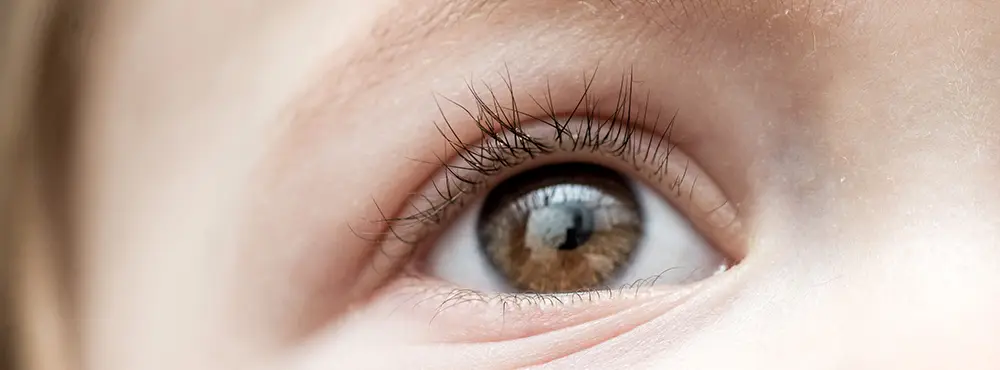What are congenital cataracts?
Congenital cataracts (or childhood cataracts) are cataracts that occur in children and are responsible for nearly 10% of all vision loss in children worldwide. They cause the lens inside the eye to go cloudy, giving the eye a milky appearance and potentially causing visual impairment.
Older babies and toddlers can also get cataracts, referred to as paediatric cataracts.
Congenital Cataracts: types
Anterior polar cataracts
These are well-defined, although often considered too small to require surgical treatment. They are located at the front of the eye's lens and there may be a family history.
Posterior polar cataracts
Unlike the other types of congenital cataracts, these appear on the back of the eye’s lens.
Nuclear cataracts
The most common form of congenital cataracts, these appear in the middle of the eye.
Cerulean cataracts
Typically, this type of cataracts doesn't cause vision problems. Their small, pale blue dots easily distinguish them and are concentrated on the lens of the eye.
What causes congenital cataracts?
There is a range of reasons as to why children may be born with cataracts or develop them. In many cases, however, it is not possible to identify the exact cause.
Possible causes of congenital cataracts include the following:
Genetic conditions
Parents can sometimes pass on a faulty gene to their children which causes them to be born with cataracts.
Cataracts can also link to chromosome abnormalities and conditions such as Downs Syndrome which are caused by these abnormalities.
Infections during pregnancy
Various infections caught by the mother during pregnancy can also cause congenital cataracts. Viruses include rubella, toxoplasmosis, cytomegalovirus, chickenpox and herpes simplex virus.
A reaction to drugs
An example of this would be tetracycline antibiotics used to treat infections in pregnant women, which have proven to cause cataracts in newborn babies.
What are the signs and symptoms of Congenital Cataracts?
If You'll be able to tell if a baby has congenital cataracts if:
- Their pupil appears grey or white
- You see a spot on the pupil
- The pupil looks as though it has a film over it
- Be aware that any of the signs above may indicate another problem other than cataract, and prompt ophthalmological assessment should be sought
Can cataracts in children be prevented?
While it's not possible to prevent congenital cataracts that are inherited, listening to the advice given to you by your midwife during pregnancy can reduce the chances of your child having congenital cataracts.
Are congenital cataracts rare?
Congenital cataracts are rare, and according to the NHS, 3-4 in every 10,000 children are affected in the UK.
Can congenital cataracts get worse?
Congenital cataracts can get worse and can cause lazy eye or amblyopia. As a result, other eye problems affecting vision can arise such as nystagmus, strabismus and problems keeping a fixed gaze on objects.
How are congenital cataracts treated?
In some cases, cataracts do not cause visual impairments; however, if the condition does begin to affect your child's sight, surgery may be recommended. Once a cataract is removed, it's unlikely to grow back.
If your doctor feels that the cataract will affect the development of your child's visual system, surgery, if the child is under the age of three months, is considered. However, if your child only has a cataract/cataracts in one eye, surgery may be required at a much earlier age.
Unilateral cataracts
Unilateral cataracts refer to having cataracts in one eye. In this case, the brain learns to switch off from the eye with a reduced vision. Instead, the brain relies on the eye without the cataract. When the brain does this, this prevents visual development in the eye with the cataract (amblyopia).
If there is significant risk of amblyopia, surgery to remove the cataract will take place early on to achieve the best visual outcome for the child. If this is not the case, using dilating eye drops is recommended in the healthy eye to force the child to use the eye, which is affected.
Nevertheless, even if the cataract is small, it can still cause amblyopia and therefore may still need cataract surgery.
Surgical treatment
During surgery, the surgeon will make a small opening in the side of the cornea to remove the cloudy lens. The natural lens gets replaced with an artificial plastic lens called an intraocular lens or IOL, a lens implant that can last for life and does not usually need replacing. Alternatively, a contact lens or glasses, as opposed to a lens implant, may be suggested. Babies may find it difficult to wear glasses so doctors may recommend contact lenses for practicality.
What is the lifetime of an intraocular lens?
An intraocular lens typically lasts for a lifetime and is, therefore, a permanent fix.
Complications-Childhood cataracts
There is a low risk of severe complications with cataract surgery; however, some of the few risks which babies and children may experience include:
- Posterior capsule opacification-this affects the artificial lens and can cause cloudiness of vision
- Glaucoma- where there is a build-up of pressure in the eye. If glaucoma is left untreated, it can permanently damage structures in the eye
- Retinal detachment-when the retina detaches from the inner wall of the eye, affecting vision
- Infection-including rare bacterial infections such as endophthalmitis which can harm sight. If an infection develops, medication or additional surgery will be required to treat the infection
- Cystoid macular oedema-this can threaten vision and is where fluid builds up between the layers of the retina
- Strabismus (squint)-where the eyes look in different direction may occur if despite treatment the operated eye is still amblyopic
Quick links:
Do I need an eye test?
Cataracts
Disclaimer: The advice in this article is for informational purposes only and does not replace medical care or an in-person check-up. Please check with an eyecare professional before purchasing any products or remedies. For information on our article review process, please refer to our Editorial Policy.

 Offers
Offers Account
Account
 Favorite
Favorite
 Basket
Basket

 OFFERS
OFFERS
















